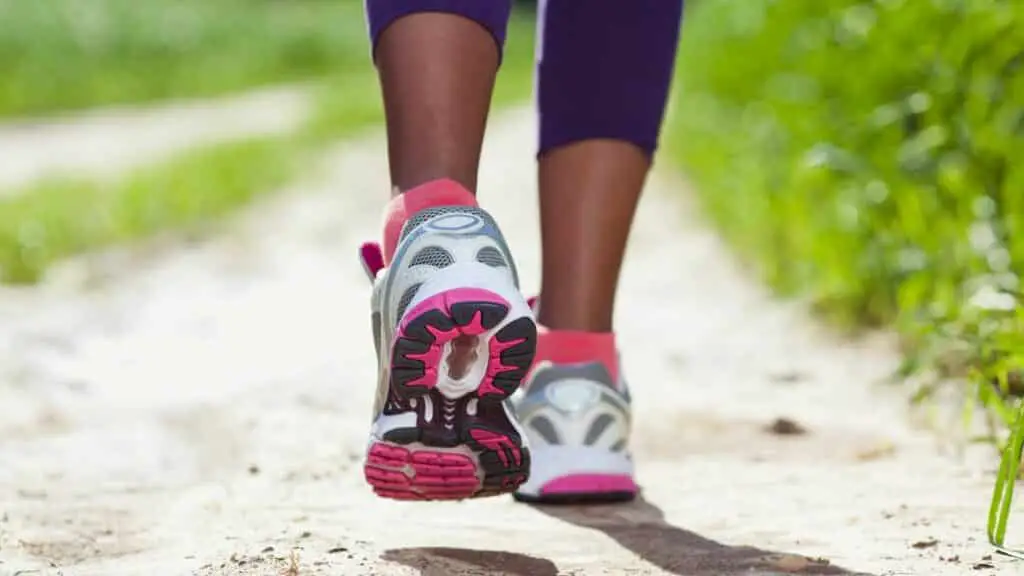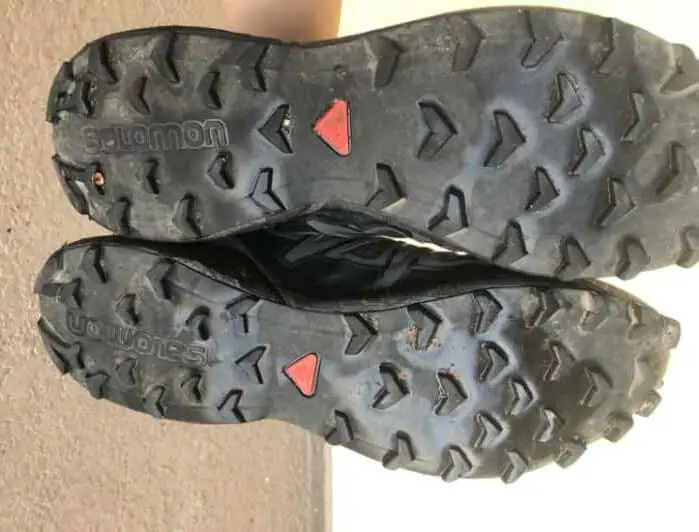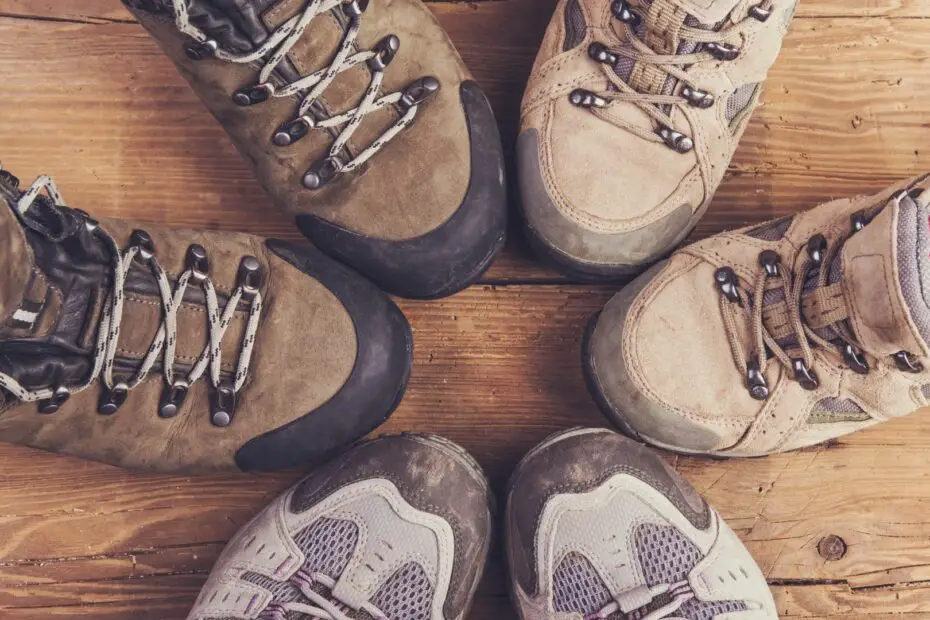It’s a common question that many runners/hikers face: can hiking shoes be used for running? The answer is, it depends. What style of hiking shoe are you using, will you be on trails or pavement, and how far do you want to run?
When I first got into trail running, I could barely afford rent. I would have loved to buy trail runners, but I already blew my savings on a new pair of hiking shoes. So, can you run in hiking shoes?
You can occasionally run in hiking shoes, but trail runners or regular running shoes would be a better choice. Most hiking shoes are designed to provide more stability, ankle support, and cushioning than running shoes. That sounds like a good thing, but it makes them heavier, which will put a lot of stress on your body. You may be able to run short distances in hiking shoes, but I wouldn’t attempt a long distance run.
Table Of Contents
Difference Between Hiking and Running Shoes
If you’re on a budget, and can only afford one pair of shoes to do both hiking and running, you might be better off with a versatile trail running shoe. They have many of the same features as hiking shoes, but are lighter weight and provide more support for long-distance running.
Whether or not you can use hiking shoes for running depends on the shoe. Obviously, it will be harder to run in a tall mid-ankle shoe or heavy hiking bot. You can get away with running in low-ankle hiking shoes, but it won’t be as comfortable as trail runners or running shoes.
The added weight of the shoe and stiff ankle will have a big impact in the way you run. It may even force your feet into an uncomfortable running position that could lead to injury.
Here are a few important differences between hiking and running shoes:
- Weight: Hiking shoes are generally heavier and bulkier than running shoes. This is because they need to provide more support and stability, especially on uneven terrain.
- Durability: Running shoes are fairly durable on pavement (300-500 miles), but they can get chewed up on the trail. Hiking shoes won’t get torn apart by sticks and other debris on the trail.
- Comfort: Running shoes are designed to be lightweight and provide cushioning for long-distance running. This makes them less ideal for hiking, as they may not provide enough support on rough terrain. Hiking shoes help with traction, but the added weight/stiffness make it uncomfortable to run.
- Tread Pattern: The outsole of hiking shoes is designed for traction on all types of terrain, while running shoes are designed for traction on pavement or smooth surfaces.
- Waterproofing: Hiking shoes often have a waterproof or water-resistant coating to protect your feet from the elements. Running shoes generally don’t offer this same level of protection, but that’s a good thing since it makes you sweat.
- Sweating: Waterproof/Water-Resistant fabrics found in hiking shoes block exterior moisture, but it traps in sweat. It reduces airflow and traps sweat leaving you with soaking wet socks.
- Breathability: Running shoes are made out of lightweight, thin fabric, so they will always offer more ventilation than hiking shoes. They even beat out trail runners when it comes to breathability.
- Toe Box: Hiking shoes typically have a wider toe box to allow for more room when walking uphill or downhill. Running shoes have a narrower toe box to provide a snug fit and prevent blisters.
- Foot Room and Laces: Hiking shoes have more foot room and longer laces, so they can be adjusted to fit over thicker socks. This increase foot instability when you try to run in hiking shoes.
If you’re planning on doing a lot of running, it’s best to invest in a pair of running shoes. However, if you only want to run occasionally, hiking shoes will suffice. Just be aware of the differences between the two types of shoes and how they can affect your run.
Hiking In A Running Shoe Is Better Than Running In A Hiking Shoe

If you can only afford to buy 1 pair of shoes for hiking/running, I recommend buying a pair of running shoes. It’s easy to hike in running shoes, but running in hiking shoes will be a much bigger challenge.
The added weight and stiffness of a hiking shoe will make it much harder to run in hiking shoes. In fact, most runners adopt a different running style when they are wearing hiking boots or shoes because the shoes are so stiff and terrain is so different.
A change in running style can quickly lead to overuse injuries on long distance runs. Your body isn’t used to the different strike pattern so you end up working different muscles and getting injured.
When Should I Run In A Hiking Shoe?
Most people choose to run in hiking shoes for a very simple yet important reason. They’re worried about ankle injuries while running through complicated terrain.
That makes sense in theory, but it’s more complicated than that. The added weight of hiking shoes and change in foot posture will force you to change the way you run. There might be less of a risk of slipping in mud or falling in technical debris covered or rocky terrain, but you can easily get injured by a sudden change in running form.
I would prefer trail runners over hiking shoes, but here are a few reasons why you may decide to run in hiking shoes.
- Weight isn’t a concern: An extra pound strapped to your feet feels like 5 on your back. Your body will quickly adjust (building your hikers legs), but it will take a few weeks.
- You can only afford to buy one shoe. A person that rarely runs might want to buy 1 pair of shoes that they can wear everywhere. Running shoes would probably be a better choice, but it’s up to you.
- Hiking shoes have more traction. Unlike hiking shoes, running shoes have basically no tread pattern on the bottom of the shoe.
- Worried about ankle injuries. Hiking shoes run a few inches up your ankle so they provide more ankle support.
- Want a water-resistant/waterproof shoe. Personally I hate running in water-resistant shoes since it makes my feet sweat, but I can see the appeal on rainy days.
Consider Trail Running Shoes Instead Of Hiking Shoes For Your Next Run

The next time you head out for a run, you may want to consider trail running shoes instead of hiking shoes. While hiking shoes are designed for, well, hiking, trail running shoes are designed specifically for running on trails.
Here are a few reasons why you should make the switch:
Trail running shoes have a more aggressive outsole than road running shoes, but they’re still comfortable enough to run in. This provides better traction on slippery or uneven surfaces. They also tend to be lighter weight and have less padding, which makes them ideal for running long distances.
And because they’re designed specifically for running, they tend to provide better support and stability than hiking shoes. You get the added ankle support and durability of a hiking shoe, with the weight, flexibility, and breathability of a running shoe.
It’s the best of both worlds. So next time you hit the trails, be sure to lace up a pair of trail running shoes! Your feet will thank you.
How To Choose A Trail Running Shoe For Hiking
When it comes to choosing a trail running shoe for hiking, there are a few things you’ll want to keep in mind. Here are a few things you need to think about: Traction, Fit, Cushion, Ankle Support, Weight, Climate, and Budget.
1) Traction

If you’ll be hiking on well-groomed trails with packed dirt or gravel, you won’t need as much traction as you would if you were running off-road. A quality pair of running shoes would probably be a better choice.
However, if you’re planning on doing any running on Rocky terrain or in mud, you’ll want to make sure your shoes have good traction. That’s where the large lugs on trail running shoes come in handy (pictured above).
Look for shoes with deep tread patterns and lugs that can grip the ground. Longer lugs are better for muddy terrain, snow, sleet, etc. but they’re terrible on roads and other hard surfaces. You may want to check out my post on using trail runner running shoes for road running for more info.
2) Fit
Next, you’ll want to consider the fit of your shoe. When you’re running long distances, so it’s important to make sure your shoes are comfortable. An uncomfortable fit leads to a change in your running pattern.
You should have enough room to wiggle your toes, but your shoes shouldn’t be too loose. If you’re planning on doing any running, you’ll want to make sure your shoes are snug enough that they won’t slip off when you’re running down the trail.
3) Cushion

Another important consideration is cushioning. You’ll want to make sure your shoes have enough cushioning to protect your feet. Trail running shoes are typically stiffer than traditional running shoes.
That’s great for increasing ankle stability, but it can be painful to run long distances. Look for shoes with extra padding in the heel and toe area. If you’re looking for more of a hybrid road/off-road shoe, consider hybrid trail runners.
Hybrid trail runners have more cushioning and less aggressive tread patterns. This increases durability on roads while giving your feet additional cushioning while running on a trail.
4) Ankle Support
You’ll want to consider ankle support when choosing trail running shoes. If you’re hiking in rough terrain, you may want to consider a shoe with higher ankle support to protect your feet.
Raised ankles will make running difficult, so it may or may not be worth it. Going with less ankle support will allow your feet to move more freely.
5) Weight

If you’re sticking to well-groomed trails, you can probably get away with a lighter shoe. But if you’re planning on hitting some rougher terrain, you’ll want a shoe with more support and protection.
Most manufacturers rate their trail runners based on the type of terrain they should be used on. Salomon rates their trail running shoes for: Road, Mixed-Terrain, Rocky, Muddy & Soft, and Snow & Ice.
Road and mixed terrain shoes will be much lighter than the others. The Salomon Sense Ride Trail Runners (pictured above) are a lightweight shoe that’s great for running. It’s more of a mixed-terrain shoe with shorter lugs, so you can even use it on the roads if you’d like.
6) Climate, Weather, and Temperature
You’ll also want to consider the climate you’ll be hiking in. If you’re hiking in hot weather, you’ll want a shoe that’s well-ventilated to keep your feet cool. And if you’re hiking in cold weather, buy a shoe with a water-resistant upper to keep your feet dry.
7) Budget
Finally, think about the type of hiking you’ll be doing. Are you an avid hiker who hits the trails every weekend? Or are you more of a casual hiker who only goes out occasionally?
Your hiking frequency will help determine how much you should spend on your shoes. If you hike often, you’ll want a higher-quality, more durable shoe. But if you only hike occasionally, you can probably get by with a cheaper shoe.
Keep these things in mind and you’ll be sure to find the perfect trail running shoe for your hiking needs!
What About Approach Shoes? When Should I Use Them?
Approach shoes are designed for scrambling and hiking on rock, but they can also be used for running. They have a sticky rubber outsole that provides traction on slippery surfaces, and a tough upper that can withstand abrasion from rocks.
Approach shoes are not as comfortable or cushioned as running shoes, so they should only be used for running through rocky technical terrain. If you don’t plan on running through rocky terrain, a trail running shoe would be a better choice.




